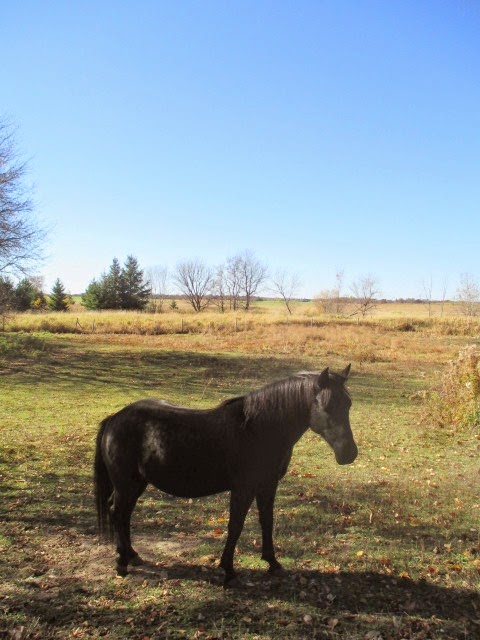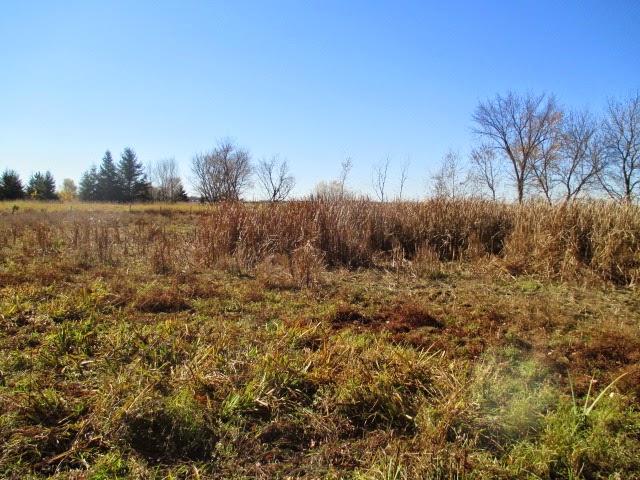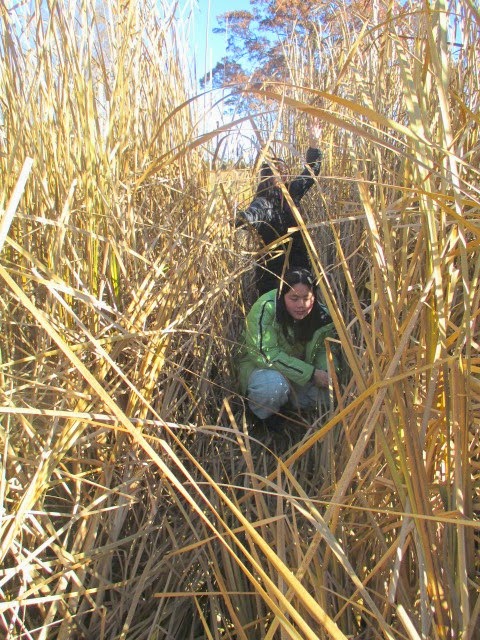Burdock in the backyard.
My dad came out one day, and I showed him my discovery thinking he'd be equally happy since he, too, loved rhubarb (rhubarb sauce, rhubarb pie...you name it).
As someone who grew up on farms during the Great Depression, he was very familiar with a wide variety of plants. Needless to say, his enthusiasm was not evident when he saw what ended up being burdock.
"That's a weed. It's not rhubarb. You need to get rid of it," he said.
"Really? There's no purpose in keeping it?" I asked.
A burr stuck in Bailey's forelock.
I took it out as soon as I noticed it.
"Not with sheep and a horse. They'll get burrs in their wool, manes, and forelock. You don't want to spend your time removing burrs from your livestock."
A tangled mess of burrs and hair from Hoss' mane.
And that was the end of the discussion. Even though burdock does have some redeeming qualities (which we found out by doing this nature study), they are not worth it when you have livestock or horses.
As noted, the distinguishing characteristic of burdock is its dark, green leaves. They are generally very large (they can grow up to 28" long), coarse and ovate, with the lower ones being heart-shaped. They are woolly underneath. The leafstalks are generally hollow.
According to the Handbook of Nature Study, "...the leaves are broad and long...and sprawl out from the growing stem in every direction, covering up and choking out all the lesser plants near them.
"The long basal leave are stretched out flat; the next higher, somewhat smaller ones are lifted at an angle so as not to stand in their light .... each higher leaf is smaller and has a shorter petiole, which is lifted at a narrower angle from the stalk; and all the leaves are so adjusted as to form a pyramid, allowing the sunlight to sift down to each part."
There are a tremendous number of flower heads which develop on one plant. The Handbook of Nature Study notes: "When in full bloom, the burdock flower-heads are very pretty .... In winter, the tough, gray stalks of the burdock still stand."
The issue my father had (and I have come to have) with burdock is what happens in the middle of summer (mid-July), throughout fall, and part of winter. The burrs have a hooked part that easily attaches to the "...clothing or covering of the passer-by; and when one gets a hold, mayhap a dozen others will hold hands and follow.
Small burrs.
"If they catch the tail of horse or cow....the animal switching about with its uneasy appendage, threshes out the seeds, and unheedingly plants them by trampling them into the ground."
Bailey in the west pasture.
Thus, burrs are excellent mechanisms for seed dispersal.
Bailey rolling in the pasture.
This would be one way that seeds could be pressed into the ground.
The Handbook of Nature Study speculates that "probably some of the livestock of our Pilgrim Fathers came to America thus burdened; for the burdock is a European weed, although now it flourishes too successfully in America."
On Wikipedia, it said that the prickly burrs were the inspiration for Velcro.
It also said that "....burrs cause local irritation and can possibly cause intestinal hairballs in pets. However, most animals avoid ingesting these plants." In the case of our dogs, Cooper will often get them caught on his fur which is longer (a German-Wirehaired Pointer mixed with a Golden Retriever) while burrs don't seem to attach themselves to Aspen (an American Staffordshire Terrier mixed with a Siberian Husky).
When Cooper comes indoors with burrs on his fur, he attempts to remove them himself by pulling them off with his mouth. Sometimes he ingests part of the burrs, and other times he doesn't. Often, though he needs help removing them since they get easily tangled in his fur.
The horses, likewise, get the burrs tangled in their forelocks; and Hoss (the miniature horse) also gets them in his mane. In just a few hours or less than a day (when they are first noticed), they are very tangled and need people to remove them.
Wikipedia also noted that birds are "...especially prone to becoming entangled with their feathers in the burrs leading to a slow death, as they are unable to free themselves."
Now...for the positive aspects of burdock. According to Wikipedia, "The roots of burdock, among other plants, are eaten by the larva of the Ghost Moth. The plant is used as a food plant by other Lepidoptera including Brown-tail, Coleophora paripennella, Coleophora peribenanderi, the Gothic, Lime-speck Pug and Scalloped Hazel.
"The taproot of young burdock plants can be harvested and eaten as a root vegetable. While generally out of favor in modern European cuisine, it remains popular in Asia .... Plants are cultivated for their slender roots, which can grow about one meter long and two centimeters across. Burdock root is very crisp and has a sweet, mild, and pungent flavor with a little muddy harshness that can be reduced by soaking julienned or shredded roots in water for five to ten minutes."
In addition to the root, immature flower stalks also may be harvested in late spring, before flowers appear. The taste is supposed to resemble that of an artichoke, to which the burdock is related. The stalks are peeled, and either eaten raw or boiled in salt water.
The stem of a stripped burdock plant.
Leaves also are eaten in spring in Japan when a plant is young and leaves are soft.
Nutrition and You notes that burdock has many health benefits:
=> Burdock roots, young shoots, peeled stalks, and dried seeds contain numerous compounds that are known to have been anti-oxidant, disease preventing, and health-promoting properties.
=> The root is very low in calories; provide about 72 calories per 100 grams.
=> Burdock root contains good amounts of the electrolyte potassium (308 mg or 6.5% of daily-required levels per 100 g root) and is low in sodium. Potassium is an important component of cell and body fluids that helps control heart rate and blood pressure.
=> The herb root contains small quantities of many vital vitamins, including folic acid, riboflavin, pyridoxine, niacin, vitamin-E, and vitamin-C that are essential for optimum health. Both vitamin C and E are powerful natural antioxidants help the human body stave off infections, cancer, and neurological conditions.
=> It also contains valuable minerals such as iron, manganese, magnesium; and small amounts of zinc, calcium, selenium, and phosphorus.
=> Burdock has been used in many folk remedies as one of the best blood purifiers. It contains certain diuretic principles, which help expel toxic products from the blood through urine.
=> The herb is used in the treatment of skin problems such as eczema (dermatitis), psoriasis, and skin dryness. The plant parts have been used as an herbal remedy for liver and gall bladder complaints.
=> Burdock leaves and stems are an appetite stimulant and a good remedy for indigestion.
After we learned about burdock, the girls worked on their nature journals. Sophia included a flattened burr on her page.
Sophia's nature journal entry.
Olivia focused on the size of the leaf and that the burrs were the inspiration for Velcro. Thus, there are two pieces of Velcro on the lower-right hand side of her page.
Olivia's nature journal page.
Next, we went outside for a walk to see where the burdock is growing. With the exception of one plant in the backyard, we didn't see any growing in the yards or east pasture.
So, we headed to west pasture. The pond is now dried up and the landscape more of a shade of tans and browns than the rich greens earlier in the summer.
Looking west towards the neighbor's cornfield.
My favorite oak tree has changed colors. It always amazes me when I think that this had been the color of the tree all along, but the green in the leaves hid this color for the entire summer.
My favorite oak tree.
We were now able to walk through the pond area to see the variety of plants that grew there during the summer and early fall.
A view looking southwest.
The pine trees in the distance are the back part of our property.
The girls rested under the big oak tree for a while after exploring the corner forest area.
The girls are sitting next to an area that the horses roll in.
Some of the trees still had brilliant leaves.
The birches and aspens still had leaves.
The contrast between the leaves and beautiful blue sky was breathtaking.
I was happy to see that our little pin tree - a tree that started on its own - is doing well.
This was a "freebie" tree that came up on its own.
Sophia was enjoying relaxing under the oak tree. With the absence of mosquitoes and other insects as well as low humidity it makes for a pleasurable time outdoors.
Sophia by the oak tree.
Bailey accompanied us as we walked around the pasture.
Bailey giving Sophia a kiss.
Looking back from the pond to the house, it is nice to see how protected the house is getting with the growing trees.
The trees are providing nice protection from the wind
as they get taller.
As we were walking in the muddy area of the pond, Sophia spotted paw prints. There were several possibilities: cat, coyote, fox, dog, or raccoon. After looking up what the tracks look like online, we determined that there were one or more raccoon that were exploring the pond. The pond is adjacent to the neighbor's cornfield, so they surely had plenty to eat.
A bit blurry, but one of the paw prints we spotted.
The paws were a good size. We compared them to Olivia's hand.
A raccoon print in mud next to Olivia's hand.
The pond area had plenty of cattails left. They were so dense that the girls were invisible when they went into them.
The girls are hiding in the cattails.
They wanted to know if I could see them. I couldn't.
They were totally hidden.
They discovered that the horses had made a passage way through the cattails.
Sophia and Olivia on the pathway through the cattails.
We went to another area of the pond and discovered even more prints.
Front and back paw prints were all over the mud.
The cattails now have burst open and all the fluffy innards are either on the stem or are carried away on the wind.
One of many cattails that have burst open.
In one section of the pond area there were tall plants that have burrs on them. They do not have prickly stems or leaves, so they aren't thistle. Yet, the big leaves that are seen on burdock also weren't present.
This plant is growing in the pond area.
It has burrs at the top of each stem.
In some ways, they reminded us of goldenrod. However, goldenrod doesn't have the burr-type bases at the bottom of the fluffy tops.
The top of these plants is soft, but
the base of the fluffy part is very prickly.
They are very tall plants and the tops of all the stems have the burrs. We are thinking that they may be a type of burdock, but we're not quite sure.
The burrs are at a perfect height for
free rides on hair, clothes, and horses.
Nonetheless, these burrs do get tangled in the horse's forelocks and manes, as shown above. For all practical purposes, we're considering these burdock since they have burrs and get entangled in clothing, fur, and hair.
Burdock seems to have advantages and disadvantages depending on where it is grown and who or what is around it. This nature study certainly opened our eyes to seeing the wide range of uses of what has been seen here as only a troublesome weed.





























4 comments:
Nice trip around your land! Burdock and other plants with burrs are quite annoying, but have their purposes. Interesting information. :)
Loved this entry!
Awesome photos and great nature journaling!
Interesting about the velcro inspiration. Maybe the person was a nature study enthusiast. The girls' journal's are lovely.
Post a Comment